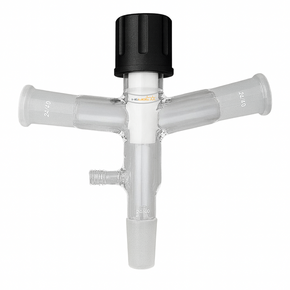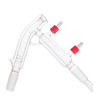
Helios
Distilation Head 24/40
Distilation Head 24/40
A distillation head is a crucial component used in laboratory and industrial distillation setups. It acts as a connector between the distillation flask (where the mixture is heated) and the condenser (where vapors are cooled and condensed back into liquid). The design of a distillation head facilitates the separation of components in a mixture based on their boiling points.
Here are the main features and functions of a distillation head:
-
Shape and Design: Distillation heads typically have a Y-shape or angled design to redirect vapor flow towards the condenser. This allows for efficient collection of the distilled liquids.
-
Vapor Pathway: They feature an outlet for vapors that can lead directly to the condenser, allowing the vaporized components to flow smoothly without obstruction.
-
Inlet for Thermometer: Many distillation heads have a side arm where a thermometer can be inserted. This allows for real-time monitoring of the temperature of the vapor, which is critical for determining when to collect distillate based on boiling point.
-
Material: Distillation heads are usually made from glass, although they can also be found in other materials suited for specific chemical compatibility.
-
Connection Points: The distillation head is designed with standard joint sizes (like ground glass joints) to allow easy connection to flasks, condensers, and other apparatus in the distillation setup.
-
Functions:
- Separation: It helps in separating volatile components from non-volatile impurities.
- Efficiency: The design improves the efficiency of vapor transfer to the condenser, leading to better yield and purer distillate.
- Temperature Regulation: The thermometer port helps in monitoring temperature, which is crucial for the success of the distillation process.
Overall, the distillation head is essential for achieving effective separation and purification of liquid mixtures in both laboratory and industrial contexts.

Distilation Head 24/40
Distilation Head 24/40
A distillation head is a crucial component used in laboratory and industrial distillation setups. It acts as a connector between the distillation flask (where the mixture is heated) and the condenser (where vapors are cooled and condensed back into liquid). The design of a distillation head facilitates the separation of components in a mixture based on their boiling points.
Here are the main features and functions of a distillation head:
-
Shape and Design: Distillation heads typically have a Y-shape or angled design to redirect vapor flow towards the condenser. This allows for efficient collection of the distilled liquids.
-
Vapor Pathway: They feature an outlet for vapors that can lead directly to the condenser, allowing the vaporized components to flow smoothly without obstruction.
-
Inlet for Thermometer: Many distillation heads have a side arm where a thermometer can be inserted. This allows for real-time monitoring of the temperature of the vapor, which is critical for determining when to collect distillate based on boiling point.
-
Material: Distillation heads are usually made from glass, although they can also be found in other materials suited for specific chemical compatibility.
-
Connection Points: The distillation head is designed with standard joint sizes (like ground glass joints) to allow easy connection to flasks, condensers, and other apparatus in the distillation setup.
-
Functions:
- Separation: It helps in separating volatile components from non-volatile impurities.
- Efficiency: The design improves the efficiency of vapor transfer to the condenser, leading to better yield and purer distillate.
- Temperature Regulation: The thermometer port helps in monitoring temperature, which is crucial for the success of the distillation process.
Overall, the distillation head is essential for achieving effective separation and purification of liquid mixtures in both laboratory and industrial contexts.






